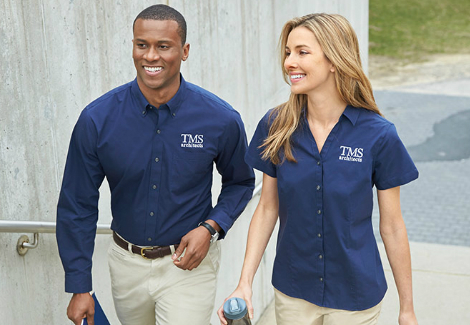
Corporate apparel plays a crucial role in shaping the work environment, influencing both employee productivity and professionalism. The clothing choices employees make, whether dictated by formal dress codes or more relaxed standards, can significantly affect their work performance and the overall atmosphere within Corporate apparel the organization. Understanding the impact of corporate apparel on these aspects helps companies tailor their dress policies to enhance both individual and collective effectiveness.
- Boosting Employee Productivity
Corporate apparel can impact productivity in several ways. First, wearing appropriate and comfortable attire can improve focus and reduce distractions. When employees feel comfortable in their clothing, they are less likely to be preoccupied with discomfort or self-consciousness. For instance, business casual attire allows for a balance between professionalism and comfort, which can enhance concentration and work output. On the other hand, overly restrictive or uncomfortable clothing may hinder movement and cause discomfort, potentially decreasing productivity.
- Enhancing Professionalism and Perception
Corporate apparel is a visual representation of the company’s brand and values. Well-chosen attire that aligns with the company’s dress code can enhance professionalism and create a positive first impression with clients and partners. Employees dressed in neat, well-fitted clothing project a sense of competence and attention to detail, reinforcing the company’s image as a professional and reputable organization. This outward appearance of professionalism can positively influence client perceptions and build trust and credibility.
- Fostering Team Unity and Cohesion
Uniform or coordinated corporate apparel can foster a sense of unity and cohesion among employees. When staff wear similar attire, it diminishes hierarchical distinctions and promotes a sense of equality and belonging. This collective identity can strengthen team dynamics and collaboration, as employees may feel more connected to their colleagues and the organization. For example, custom-designed team shirts for company events or casual Fridays can enhance team spirit and camaraderie, contributing to a more cohesive work environment.
- Reflecting Company Culture and Values
The type of corporate apparel adopted by a company reflects its culture and values. Organizations with a more formal dress code may emphasize traditional professionalism and a serious work environment, while those with a casual dress code might prioritize flexibility and creativity. By aligning apparel with company culture, businesses can reinforce their values and expectations. For instance, a tech company with a relaxed dress code may encourage innovation and comfort, while a law firm with a formal dress code may emphasize tradition and seriousness.
- Influencing Employee Morale and Engagement
Corporate apparel can also impact employee morale and engagement. Employees who feel that their attire is both appropriate and stylish are likely to feel more confident and satisfied with their work environment. A thoughtful dress code that balances professionalism with personal expression can enhance job satisfaction and motivation. Conversely, a rigid or outdated dress code that does not take employees’ preferences into account may lead to dissatisfaction and disengagement.
- Enhancing Brand Visibility and Consistency
Corporate apparel serves as a tool for enhancing brand visibility and consistency. Employees wearing branded clothing help promote the company’s image and values, creating a unified and recognizable presence in public and during client interactions. This consistent branding can reinforce the company’s identity and increase brand awareness. For instance, staff in logoed apparel at trade shows or client meetings can enhance the company’s visibility and create a professional and cohesive image.
- Adapting to Changing Work Environments
The evolving nature of work, including remote and hybrid models, requires adaptable corporate apparel strategies. For remote workers, the focus may shift to comfortable yet professional home office attire that maintains a sense of professionalism during virtual meetings. For hybrid work environments, providing flexible dress code guidelines that accommodate both office and remote work can help balance comfort with professionalism. Adapting corporate apparel to these changing needs ensures that employees remain productive and professionally presented in various work settings.
In conclusion, corporate apparel has a significant impact on employee productivity and professionalism. By thoughtfully designing dress codes that balance comfort, professionalism, and company culture, organizations can enhance employee performance, foster team unity, and strengthen their brand image. Understanding and leveraging the influence of corporate apparel ensures that it serves as a positive force in shaping a productive and professional work environment.
